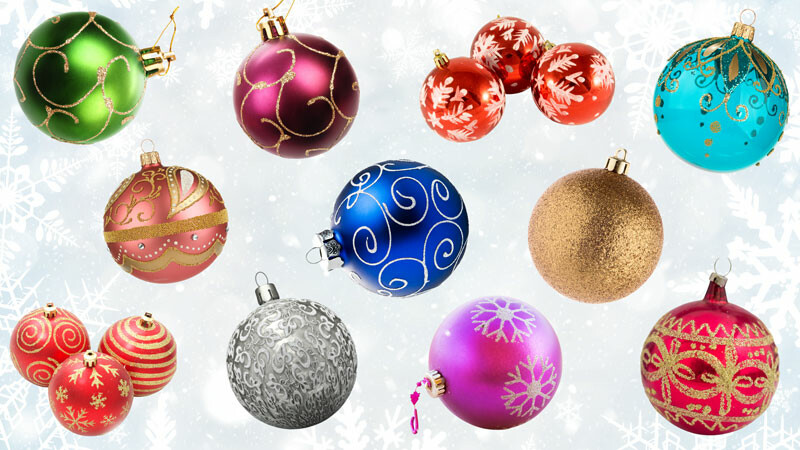
Product Spotlight: Christmas Ornaments
From simple greenery to modern baubles of glass, plastic and metal, Christmas ornaments have long been a part of holiday festivities.
Rick Cundiff
You see them all over town, just hanging out. In public squares, in department stores, in schools and bars. They even gather around trees in private homes.
Yes, we’re talking about that classic decoration, and in recent years, custom promotional product – Christmas ornaments!
Christmas trees and colorful ornaments go together like peanut butter and jelly, or better yet, cookies and milk for Santa. They’re as much a part of the season as holiday parties, carolers, tinsel, snowmen (and -women) and eggnog.
Did you ever stop and wonder how the tradition of decorating a tree with ornaments began? Neither did we, so we thought we’d look into it for this month’s Product Spotlight!
Before the Ornaments (and Even Before the Tree)
Of course, ornaments would be nowhere without Christmas trees. Actually, they probably would be somewhere, rolling around on the floor after cats knocked them off tables, counters and desks. But for our purposes, the tree is the basis for the ornaments.
What we know today as Christmas trees actually began before the Christian holiday existed. In ancient times, early civilization such as the Romans, Egyptians and Celts decorated their homes with evergreen branches and other greenery to mark the winter solstice. The greenery symbolized ongoing life and the promise of spring in the darkest time of the year.
By the Middle Ages (approximately from the fall of the Roman Empire in 476 A.D. to the fall of Constantinople in 1453 A.D.), decorations still included greenery to include fruits, nuts and other items. A “Paradise Tree,” an evergreen tree decorated with apples, became a staple of medieval plays, where it represented the Garden of Eden.
The 1500s – Enter the Christmas Tree
In the 16th century, central European countries introduced the concept of the Christmas tree. Protestant Christian reformer Martin Luther reportedly was the first person to add lighted candles to an evergreen tree. (While lovely, it’s hard not to wonder how many homes burned down in that pre-electric era.)
Around the middle of the century, skilled glassblowers in the town of Lauscha, Germany created the original glass ornaments. These handcrafted baubles, originally simple round globes and later in other shapes, proved popular throughout Germany.
The Queen Is Impressed
By 1832, even England’s Queen Victoria delighted in seeing a Christmas tree covered in lights and ornaments. In the 1840s, a London newspaper published an engraving of the Royal Family decorating a tree. That led to the widespread adoption of decorated Christmas trees in Britain. Lauscha began exporting its ornaments throughout Europe.
Lauscha’s artisans were soon able to add delicate hand-painted scenes to the once-clear ornaments.
Toward the end of the century, American retail entrepreneur F.W. Woolworth discovered the ornaments of Lauscha’s craftsmen on a trip to Germany. In 1880, he imported the baubles to the United States to sell in his fledgling retail stores.
Although American-made glass ornaments existed for about a decade earlier, Woolworth’s retail empire made the Lauscha ornaments part of the U.S Christmas traditions. Within 20 years, the company had imported more than 200,000 German ornaments, and Christmas decorations alone accounted for more than $25 million in sales.
More than just the volume sold, Woolworth was responsible for spreading the popularity of glass Christmas ornaments across the nation. With more than 1,000 stores nationwide, they were easy to find. In some quarters, he’s considered the one who introduced the famed pickle ornament to the U.S., although that’s up for debate.
Over the years, ornaments became cherished keepsakes, often passed down through generations of families. The sentimental attachment brought back fond memories of childhood Christmases for many, and established new memories for the next generation along the way.
More American-Made and New Materials
With the advent of World War I, the importation of German glass ornaments stopped, at least temporarily. American companies, including Corning Glass Works, filled the void with U.S. made products.
Originally, those products included glass ornaments in the style of the German-made ones. By the 1950s, new materials such as plastics arrived, creating ornaments that were lighter and less fragile. It also made personalization possible on a larger scale.
Modern Ornaments
Today’s ornaments come in many styles and materials, including glass, plastic, wood, metal and ceramic. It’s possible to find ornaments with images of just about any pop culture meme, celebrity or tourist attraction. Some even feature built in lights and can play Christmas carols.
Although mass-produced ornaments still command the majority of the market, handmade one-of-a-kind DIY ornaments have become increasingly popular in recent years as well.
The advent of 3D printing has made creating unique styles and shapes easier than ever before. And ornaments lovingly crafted by a family member are sure to become cherished keepsakes for generations.
Promotional Ornaments
With the advent of modern printing techniques, it’s a breeze to customize Christmas ornaments. Add a family message for the big gathering at Grandma’s house. Or imprint your company logo and give them to customers and employees as a promotional item. They can easily carry a message of the season for any reason you want.
Ornaments Are Here To Stay
From simple greenery to today’s modern designs, there’s a Christmas ornament for just about everyone. Whether on a family tree, or in a public display, holiday ornaments keep giving a festive touch to the season wherever you go.
Rick Cundiff
Content Director, Blogger
Rick Cundiff spent 15 years as a newspaper journalist before joining TJM Promos. He has been researching and writing about promotional products for more than 10 years. He believes in the Oxford comma, eradicating the word "utilize," and Santa Claus.
